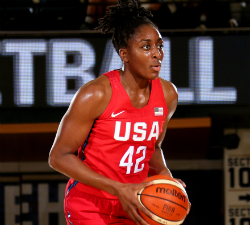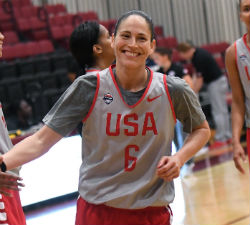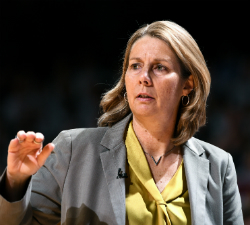10 Things to Know About the 2018 FIBA Women's Basketball World Cup

Held every four years, the FIBA World Cup is the world’s largest women’s basketball international competition. The 2018 FIBA Women’s Basketball World Cup is taking place in Tenerife, Spain from September 22-30.
Here are ten things to know about this year’s championship — the 18th in history — and the U.S. Women’s National Team:
1. FIBA World Cup Dates
Group Phase (Sept. 22-25): Like most international championship tournaments, the FIBA World Cup is set up in a bracket formation. Beginning with a preliminary round, teams are divided into groups of four to form Groups A, B, C and D. Each team will face each other once in this phase. USA is in Group D, along with China, Latvia and Senegal. The team with the most wins in each group automatically qualifies for the quarterfinals.
Quarterfinals Qualifications (Sept. 26): The eight teams coming in second/third in their groupings will play in single-elimination games for a spot in the Quarterfinals.
Quarterfinals (Sept. 28): Quarterfinal matchups will feature the first-place teams from the groupings phase and winners from quarterfinals qualifiers. The winners of these games advance to the semifinals. The four losing teams will play in classification matches for places 5-8.
Semifinals (Sept. 29): Winners of the Semifinals head to the Finals for the championship game (Sept. 30), and the two losing teams play to determine 3rd and 4th place.
Finals (Sept. 30)
2. How to Follow the World Cup
You can keep up with the U.S. Women’s National Team and other WNBA players participating in the FIBA World Cup on @WNBA social handles, as well as WNBA.com.
Most games will be televised on ESPN+ and the championship will air on ESPN on September 30.
3. The Competition
The U.S. Women’s National Team earned an automatic bid into the World Cup after winning gold in the 2016 Olympics. The host nation, Spain, has also automatically earned a spot in the tournament. An additional 14 countries will also compete in the World Cup after qualifying through the FIBA Continental Cups this past year. These 14 nations include:
- Nigeria and Senegal from Africa qualifiers
- Argentina, Canada and Puerto Rico from the Americas qualifier
- Australia, China, Japan and Korea from the Asia qualifiers
- Belgium, France, Greece, Latvia and Turkey from the European qualifiers
4. Which WNBA players are participating?
USA’s roster features 12 WNBA standouts — click here for more on the team.
Headlining the roster are Sue Bird and Breanna Stewart, fresh off a 2018 WNBA title with the Seattle Storm. All-time leading scorer Diana Taurasi also returns to the backcourt to join Bird, her longtime friend. Keys to the roster include…
Stacked Frontcourt – The USABWNT frontcourt is one you dream of having… and even that may be an understatement. Between seasoned veterans Tina Charles, Nneka Ogwumike, Elena Delle Donne and Brittney Griner, you also have young stars like the 2018 WNBA Rookie of the Year A’ja Wilson and 2018 WNBA and WNBA Finals MVP Breanna Stewart. The forwards give USA overwhelming athleticism, the ability to play any style and offensive versatility in playing both inside and outside.
Transitioning Backcourt – The backcourt’s strength comes in veteran experience and leadership, being that some of the very best in the WNBA play the position. They have two four-time Olympic gold medalists and three-time WNBA champions in Sue Bird and Diana Taurasi. Alongside them there’s 2015 Rookie of the Year Jewell Loyd, 2017 No. 1 Draft pick Kelsey Plum and former WNBA All-Star Layshia Clarendon. It’ll be interesting to see how the rotation evolves throughout the entire tournament — and who emerges as the guards of the future.
A number of international WNBA players are also representing their respective countries in the tournament, headlined by Australia’s Liz Cambage — the league’s leading scorer this past season. Click here to see which international players are participating.
5. USA’s History at the FIBA World Cup
USA Basketball’s international dominance has extended to the FIBA World Cup, as the United States owns more titles (9) than any nation, including the past two.
Since the World Cup’s inception in 1953, USA has a 103-21 record in a total of 16 appearances, 12 of which resulted in a medal. But the team has not only won; they have frequently dominated. The United States has averaged a 28.8-point margin of victory over its opponents.

A host of WNBA superstars have fueled that dominance, from Hall of Famers Cynthia Cooper, Lisa Leslie, Katie Smith and Tina Thompson to current greats like Sue Bird, Maya Moore and Diana Taurasi — just to name a few.
6. USA’s Biggest Challengers
Just four teams have combined to win the 18 World Cups throughout history. Trailing the USA in first-place finishes are the Soviet Union (6), Australia (1) and Brazil (1).
In this year’s World Cup, the expected top challengers include…
- Australia – If there’s any team that can knock off USABWNT and prevent their gold three-peat, it’s the Australians — along with Brazil, the only team to have won this tournament in the past two decades-plus. Coached by former WNBA champion Sandy Brondello of the Phoenix Mercury, Australia is jam-packed with familiar WNBA faces like Rebecca Allen (New York Liberty), Liz Cambage (Dallas Wings), Cayla George (Dallas Wings), Leilani Mitchell (Phoenix Mercury) and Stephanie Talbott (Phoenix Mercury). Cambage alone could make the team a contender, coming off a breakthrough season in which she led the WNBA in scoring and posted a record 53-point game. The Aussies could challenge the Americans early on if they finish second in their grouping, as the winner of the Quarter-Final Qualifiers will face USABWNT in the Quarter-FInals.
- Spain – The host country is not one to miss either. Currently No. 2 in FIBA’s rankings, the Spaniards won the 2017 FIBA EuroBasket qualifier and look to continue pressing forward into the World Cup. Although they suffered a great loss to their roster in Sancho Lyttle (ACL), Spain still will be a major competitor in the tournament. With 2x EuroLeague champion and 15-year Spanish National Team veteran Laia Palau, 2017 EuroBasket tournament MVP Alba Torrens and 2014 WNBA second-round pick Astou Ndour (currently with Chicago Sky), Spain could challenge the Americans later on in the tournament in either the Finals or Semifinals.
- France – USA has another major competitor in No. 3-ranked France, who is led by WNBA vet Sandrine Gruda. Gruda plays alongside Endy Miyem, who spent the last year with the Minnesota Lynx under USABWNT assistant coach Cheryl Reeve. The French just recently faced off against USA in an exhibition in Antibes and showed that they are not a team to doubt. Although the Americans pulled away in the final five minutes to win, 77-60, Gruda (12 PTS) and Marine Johannes (11 PTS) made it a tough battle down the stretch. This French team could also challenge the Americans early in a potential quarterfinals matchup.
- Canada – Another team to watch out for during the tournament is one not too far from the USA, and that’s Canada. In one of the final domestic USAB domestic exhibitions, Canada looked primed and ready to make a statement. In that exhibition, New York Liberty rookie Kia Nurse dropped a game-high 22 points for the Canadians, who led most of the game until the fourth quarter, when USA outscored them 26-12. Although Canada has taken a major hit in losing Kayla Alexander from the Indiana Fever due to injury, they still have a strong piece in forward Natalie Achonwa (Indiana Fever) and an experienced roster. Veteran leader Miranda Ayim has been a part of the national team since 2005 and even led them to the 2017 FIBA Women’s AmeriCup title. Don’t be surprised if Canada makes a deep run.
7. What’s at Stake for USA
Elusive three-peat – Although the USABWNT has had a largely successful stretch, the one thing they’ve never achieved is a World Cup three-peat. Every third World Cup, some team has come along to upend USA’s dreams at taking home the gold for the third straight time. It was Brazil in 1994, then Australia in 2006, but this time the Americans will look to come out on top.
2020 Olympic Qualification – The winner of the 2018 FIBA Women’s World Cup earns an automatic bid to the upcoming 2020 Olympic Games in Tokyo. The USA has been even more dominant on the Olympic stage, having won six straight golds dating back to 1996.
8. From WNBA Champs to FIBA World Cup
After winning the 2018 WNBA championship, the Seattle Storm’s Sue Bird, Jewell Loyd and Breanna Stewart are expected to meet the team in Tenerife, Spain early in the week to train for and compete in the FIBA tournament for the USABWNT. The trio of champions will look to quickly blend back into the USABWNT’s offensive and defensive schemes and lead the Americans to their third consecutive FIBA World Cup title.

Stewart could also bring in her third award of the year, as she continues to play the best basketball of her career thus far. Averaging 21.8 PPG this past WNBA regular season and 24.6 PPG during the playoffs, Stewart is sure to be one of the major scorers on the USABWNT team. If the USA is able to bring home yet another gold, the 2018 WNBA MVP could potentially come home with the FIBA World Cup MVP as well.
9. Coaching Staff
Not only is Hall of Famer and South Carolina head coach Dawn Staley taking the reins, but four-time WNBA champion Cheryl Reeve (Minnesota Lynx) is also on the coaching staff. Oh, and there’s more… the coach that just brought the WNBA title back to Seattle, Dan Hughes? He’s also on board. As is George Washington head coach Jennifer Rizzotti, a WNBA veteran. And even though University of Connecticut legend Geno Auriemma stepped aside as head coach last year, he remains involved as a special adviser to the program.

10. Veteran Leadership
Sue Bird and Diana Taurasi have been a part of the U.S. Women’s National Team for more than a decade and have led them to Olympic and FIBA World Cup gold medals. The value they add to the team goes beyond their ability to toss no-look dimes and sink deep threes. These two understand and visualize the game unlike any other and have the ability to share a lot of their experiences with many of the younger players. Their expertise should prove vital given how quickly the team needs to gel and how many young players are being worked into the program.

,xPosition=.5,yPosition=.5)
,xPosition=.5,yPosition=.5)
,xPosition=.5,yPosition=.5)
,xPosition=.5,yPosition=.5)